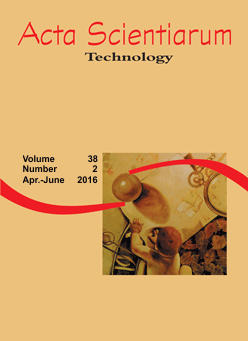<b>Evaluation of compressive strength and water absorption of soil-cement bricks manufactured with addition of pet (polyethylene terephthalate) wastes
DOI:
https://doi.org/10.4025/actascitechnol.v38i2.28458Palavras-chave:
soil-cement bricks, PET, compressive strength, water absorptionResumo
This paper presents the evaluation of compressive strength of soil-cement bricks obtained by the inclusion in their mixture of PET flakes through mineral water bottles grinding. The Polyethylene Terephthalate (PET) has been characterized by its difficulty of disaggregation in nature, requiring a long period for this. On the other hand, with the increase in civil construction activities the demand for raw material also increases, causing considerable environmental impacts. In this context, the objective of this research is to propose a simple methodology, preventing its dumping and accumulation in irregular areas, and reducing the demand of raw materials by the civil construction industry. The results showed that compressive strengths obtained were lower than recommended by NBR 8491 (Associação Brasileira de Normas Técnicas [ABNT], 2012b) at seven days of curing time. However, they may be used as an alternative solution in masonry works in order to not submit themselves to great loads or structural functions. The studied bricks also presented water absorption near to recommended values by NBR 8491 (ABNT, 2012b). Manufacturing costs were also determined for this brick, comparing it with the costs of other brick types. Each brick withdrew from circulation approximately 300 g of PET waste. Thus, for an area of 1 m2 the studied bricks can promote the withdrawal of approximately 180 beverage bottles of 2 L capacity.
Â
Downloads
Downloads
Publicado
Como Citar
Edição
Seção
Licença
DECLARAÇíO DE ORIGINALIDADE E DIREITOS AUTORAIS
Declaro que o presente artigo é original, não tendo sido submetido í publicação em qualquer outro periódico nacional ou internacional, quer seja em parte ou em sua totalidade.
Os direitos autorais pertencem exclusivamente aos autores. Os direitos de licenciamento utilizados pelo periódico é a licença Creative Commons Attribution 4.0 (CC BY 4.0): são permitidos o compartilhamento (cópia e distribuição do material em qualqer meio ou formato) e adaptação (remix, transformação e criação de material a partir do conteúdo assim licenciado para quaisquer fins, inclusive comerciais.
Recomenda-se a leitura desse link para maiores informações sobre o tema: fornecimento de créditos e referências de forma correta, entre outros detalhes cruciais para uso adequado do material licenciado.















